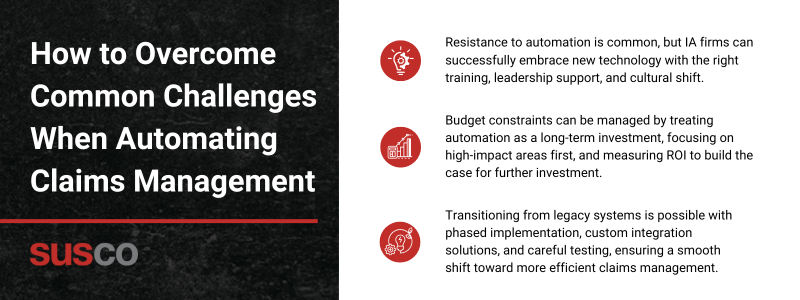
The future of claims management lies in automation, yet many Independent Adjusting (IA) firms are held back by the hurdles of transitioning from manual processes. The promise of greater efficiency, precise accuracy, and improved client satisfaction is clear—but real-world obstacles, like resistance to change, tight budgets, and outdated legacy systems, often stand in the way.
Addressing these challenges isn’t optional for IA firms looking to stay competitive—it’s essential. This article looks at the core barriers that block progress and provides actionable strategies to navigate them. If you’re serious about future-proofing your operations, the insights here could make all the difference.
Resistance to Change
Resistance to new technology is a familiar obstacle in the insurance industry, and many Independent Adjusting (IA) firms face this challenge when implementing automation. Employees may worry that automation will threaten their jobs or disrupt established workflows, while leadership might hesitate to invest in unfamiliar tools.
However, failing to address these concerns can stall progress and prevent IA firms from reaping the benefits of automation.
Overcoming Resistance requires a strategic approach that focuses on education, clear communication, and active leadership support:
- Training and Education: Equip employees with the knowledge they need to feel confident about automation. Provide hands-on training and offer accessible resources highlighting how automation improves their day-to-day work rather than replacing them.
- Leadership Buy-In: Digital transformation succeeds when leadership is entirely on board. Leaders must actively advocate for automation and model its use to show that it’s a priority for the company’s future.
- Create a Positive Automation Culture: Highlight how automation can boost efficiency and streamline processes. Celebrating early wins and showing the tangible benefits can make more employees excited about the change.
Building an automation-friendly culture takes time, but it’s an investment that pays off in improved workflows and a more adaptive team. Addressing resistance thoughtfully and proactively allows IA firms to ease the transition and move toward a more efficient, tech-driven future.
Budget Constraints
Cost concerns can make automation seem out of reach for many IA firms. The fear of significant upfront expenses and uncertainty about the return on investment often leads to hesitation.
But avoiding automation due to budget worries can cost firms far more in the long run—through inefficiencies, slower claims processing, and lost opportunities for growth.
Making Automation Affordable means taking a more strategic, long-term view:
- Think of Automation as an Investment, not an Expense: Instead of focusing solely on the upfront costs, consider the potential savings over time. Automation reduces labor hours, minimizes costly errors, and speeds up claims processing, directly impacting profitability.
- Focus on High-Impact Areas First: You don’t need to automate everything simultaneously. Start with the processes that create the most drag on your operations, like data entry or reporting. This phased approach allows you to see immediate gains while spreading out costs.
- Leverage ROI to Build the Case: Automation pays off—often faster than expected. By measuring the time saved, improved efficiency, and increased capacity, you can demonstrate a strong return on investment, which makes the upfront costs easier to justify.
Balancing budgets and innovation can feel like a tightrope act, but smart investments in automation pave the way for long-term success. IA firms can unlock efficiency without breaking the bank by focusing on high-impact areas and viewing automation as a strategic investment.
Transitioning from Legacy Systems
For many IA firms, legacy systems represent a significant obstacle to adopting automation. These outdated platforms weren’t built for modern integration, and upgrading them can feel like forcing a square peg into a round hole.
Yet sticking with these systems only leads to more significant inefficiencies and missed opportunities to streamline operations.
Making the Transition Work requires careful planning and a step-by-step approach:
- Start Small with Phased Implementation: Ripping out old systems overnight isn’t realistic or necessary. Begin by automating the most inefficient or manual processes. This phased approach lets you see results quickly and minimizes disruption as your team adapts to the new system.
- Use Custom Integration Solutions: Every firm’s tech stack differs, so there’s no one-size-fits-all solution. Partnering with an experienced provider like Susco allows you to create custom integrations that connect legacy systems to modern platforms without starting from scratch.
- Test and Optimize: Don’t rush the process. First, test the new systems in small-scale operations, ironing out any issues before full implementation. This reduces the risk of downtime or data migration problems and ensures a smoother overall transition.
Transitioning from legacy systems can seem daunting, but taking a strategic, gradual approach ensures success. By focusing on custom solutions and testing along the way, IA firms can seamlessly integrate automation and set themselves up for long-term growth.
Automating claims management doesn’t have to be an uphill battle. While challenges like resistance to change, budget concerns, and legacy systems may seem daunting, they are far from impossible. With the right approach—focused on phased implementation, leadership buy-in, and strategic investments—your IA firm can successfully transition to an automated system that streamlines processes and drives growth.
The barriers to automation are real, but now you have practical strategies to address them head-on. Whether educating your team, finding budget-friendly solutions, or navigating the complexities of legacy systems, the path forward is clear.
You can achieve the benefits of automation—faster claims processing, improved accuracy, and enhanced client satisfaction.
Susco has the solution
Ready to take the next step? Contact Susco to see how our tailored automation solutions can help you overcome these challenges and transform your claims management processes today.